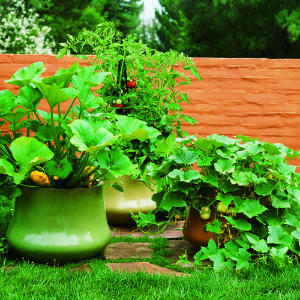Problems Growing Squash in Containers
 Question from Martha:
Question from Martha:
I have 2 squash plants planted in containers, side by side. They started out beautiful. I got 2 nice squash so far. Lately, the tiny squash have been drying up before they get very big, and also the leaves are turning brown underneath the plant. Help! Thank you.
Answer from Pat:
Yellow and browning leaves and shriveled fruit can often mean lack of nutrients, especially nitrogen, or can mean overwatering. Squash plants are also subject to several diseases, such as blight, bacterial wilt, and mildew. You do not mention white on top of the leaves, but mildew causes whiteness on top and browning beneath and finally browning of whole leaves. (See my video on what to do about mildew. One cure for plant diseases such as mildew is to spray the plant with an organic product called ‘Serenade’ which contains a beneficial fungus which attacks and kills the fungus disease.)
You do not describe the type of browning, whether spots or all over. The various diseases of squash have a variety of symptoms and browning can be in spots and in some cases lead to holes through the leaf. To avoid disease problems altogether, always begin squash from seeds of a good disease-resistant variety, not from a plant you buy in a nursery container because when you purchase a container-grown squash plant it will usually be a cheap variety, not disease resistant variety, and also is most likely to be infected with a disease already when you buy it. I have seen very sorry looking squash plants in nurseries and I always wonder why folks don’t plant squash from seeds when the seeds sprout so quickly and easily.
Now to discuss nutrition: Plants growing in containers are dependent on the gardener to give them the soil mix and food they need for healthy growth. However, I am taking it for granted that you filled your container with a good quality potting soil, not garden soil. Filling containers with garden soil is a recipe for disaster. I also imagine that you have fertilized, according to package directions, with a balanced organic fertilizer appropriate for vegetables. Diluted fish emulsion can work well for vegetables in containers, since it does not burn. Plants that are not fed will go yellow or brown and the fruit will abort and fall off, as you have described.
Squash needs plenty of room and a large container. A half barrel size is about the smallest one can go. Early in the season before the sun is so hot it is possible perhaps to get some fruit, as you did, but once the weather warms up and the roots inside the container wind around the inside of the container where the sun hits, those roots will fry from heat and they literally burn. It is natural that some early leaves might go brown and shrivel up, but in a really healthy plant most of the leaves will be large and stand up high to shade the fruit. Next time plant squash in a large container, or begin by planting one of the miniature varieties especially designed for growing in containers. Even a raised bed is sometimes not big enough for an ordinary squash plant, since one squash plant needs all the space in the bed.
Sometimes people overwater their vegetables. If the soil mix is soggy wet, as can happen in containers, or if it is uneven in moisture this can result in problems. Squash like best to be grown in the ground and to be watered deeply and infrequently instead of shallowly and often. Soil mix in containers dries out quickly and this forces gardeners to water the plants more often than optimum conditions require.
As far as the drying up of little fruits, this too can be a result of root burn. Another possibility is that there were no bumble bees in your garden so they never got pollinated. Try hand-pollinating the flowers as demonstrated in my video on the subject. (Click on “videos” in the right hand column and then click on “See all 24 videos”.)


i planted yellow squash from a small plant in containers [cloth like].they are growing very large and pretty plants,and flowering well [yellowflowers]but no squash, what am i doing wrong?this is my first time thank you
Cucurbits often make a great many male flowers before the female flowers appear. (Female blossoms have little immature fruits beneath the flower. Males just have a stem. This may be the problem. The other possibility is that you have both sexes of flowers but you don’t have any bumble bees. In that case flowers often fall off. See my video on this problem and its solution, which is to hand pollinate. http://www.youtube.com/watch?v=5Qv1_dkQLiQ